
INDEX | HEALING WISE | Q & A with SUSUN | GREEN BLESSINGS
THE LIBRARY | PEOPLE MAKING CHANGE | GODDESS ART GALLERY
Healing Wise ...
with Susun Weed
Grasses
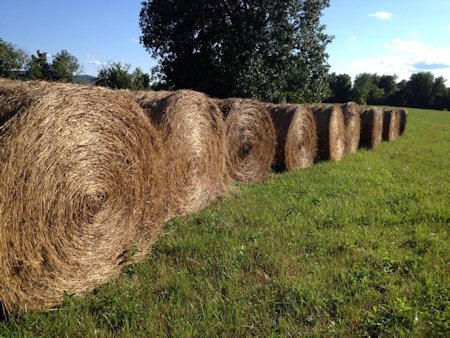
A garden catalog (Heronwood) says it poetically: "No wonder visitors feel drawn to the grasses -- we were born in them. Grasses signify water and whisper, 'You're home," more than any other group of plants."
Few people think of grass as a flowering plant; but it is. Many of us think of grass as a lawn or a golf course, not the sacred sustenance of human kind; but it is. Our ancestors had great respect for the grasses. They, in their multitude, are the beating heart of life on earth, the prime mover of agriculture, and the tuning fork of universal nourishment. The grass family -- the Poaceae -- is found in every habitat all over the world, and includes more than 10,000 plants, all of which bear edible seeds.
Grass flowers, it is true, are not fancy. You'll need a magnifying lens to see them clearly . They don't have showy, colorful petals. They just have what's needed: male stamen for pollen, female pistil to capture the pollen and gestate the seed.
And how we value those seeds. Whether it is wheat or rye, oats or barley, corn or millet or rice, almost every person on the planet bases their meals on grain, the seeds of grass. We honor the grain mother whose seeds support our lives: Corn Mother, Ceres (who gives us " cereal"), Demeter, Amaranth Grandmother. Her names are as numerous as Her nourishing seeds, as beautiful as Her seas of golden rippling grass. She sustains us with Her gracious bread of life: mana. "Corn," that is, grain, was the greatest of the Eleusinian mysteries.
"Sedges have edges; rushes run round; grasses have joints," is the saying I learned to help me distinguish between three look-alike plant families. Sedges, fond of wet places, flower from the sides of stalks which have edges. Rushes, also fond of wet places, flower from the top and have round stalks, no edges, like grass. Grasses prefer dry places and flower from the top of round stalks which are jointed, like bamboo, a woody grass. Pluck a flowering stalk of grass and see if you can find the joints. Then, look at the leaves.
Like the lily family, members of the grass family have flat, long, narrow leaves with parallel veins. Unlike lily leaves, grass leaves are micro-serrated along the edge. If you gently pull your fingers up the sides of a grass leaf you'll find it's as sharp as a razor. Careful! It can cut! That's one reason we eat the seeds of the grasses and leave the leaves to the animals (with the exception of those who drink wheat grass, a tasty juice which, unfortunately, lacks value as either a curative or a nutritive).
Sally Fallon, author of Nourishing Traditions Cookbook and advocate of Weston Price, reminds us that grazing animals and grasses benefit each other. It's not a choice between plants and animals, grain or meat. Our planet, and our bodies, need both. Without cattle eating winter wheat shoots, we would lose more than half our grain crops. Why? Because, although grass roots and leaves are extremely cold hardy, the jointed flower/seed stalks are not. Most wheat is sown in the fall, when the soil is drier and easier to work, rather than in the spring when the soil is wet and likely to rot the seeds. If the late fall weather is not cold, however, the grass will start to flower too soon. Pasturing cattle on it prevents this, giving us healthy grass-fed meat and grain to eat as well.
One of my favorite herbs -- oatstraw -- is a grass. Oatstraw is the dried leaves, or straw, of the plant that gives us the grain oats, found in most households as rolled oats. I use a full ounce (by weight) of dried oatstraw, with or without seeds, in a quart of boiling water, steeped at least four hours, to make a restorative tonic. Oatstraw is considered an herb of longevity in India. American herbalists value it as a strengthener and nourisher to the nerves. Like oats themselves, oatstraw infusion is heart healthy and cholesterol-lowering. Many a menopausal woman has praised oatstraw's cooling, calming ways.
There are many stories of grasses. Listen to them; let them take you home. Let them take you back to your Ancestral, sacred self. Herbal medicine is people's medicine, heart medicine -- free, simple, and accessible, a gift of love from our Mother.
Green Blessings.
Herbal Adventures with St. Joan's Wort
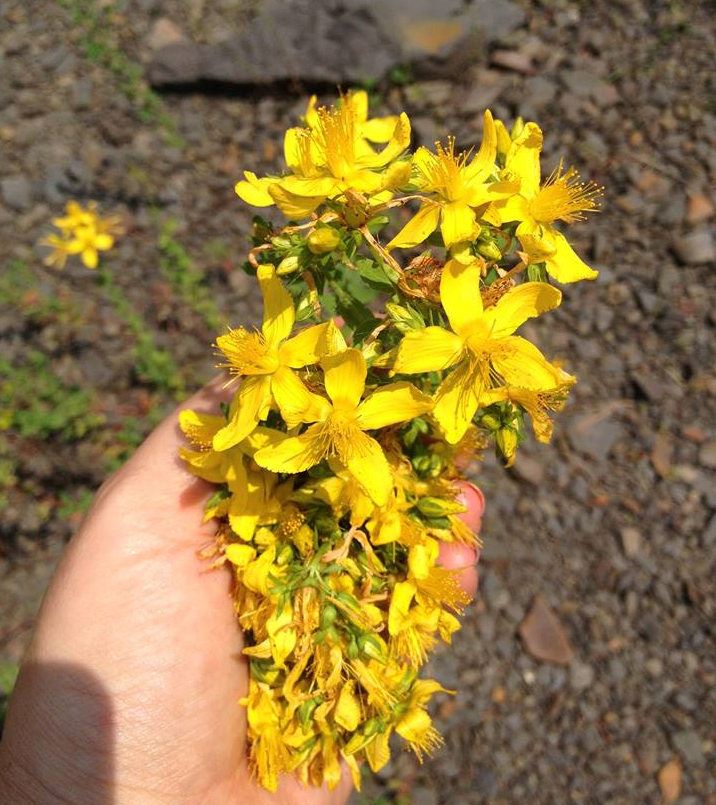
It was a snowy winter night when my sweetheart brought home the brochure and said: "Let's take a horseback riding vacation." Despite the fact that I am only an occasional rider, I did grow up in Texas, and spending a week in the saddle didn't seem like a big deal to me. We looked at the pictures, read the descriptions of the trips, and began to fantasize ourselves in far-away places riding free and easy. Where would we ride? Ireland? France? Italy? England? Which trip would we take?
It was the herbs of Provence that decided for me; and my sweetheart, good naturedly, went along. We would fly to Marseilles, France, and be driven from there to the ranch, where we would get our horses. Each day's ride, said the brochure, would take 8-9 hours and we would stay at a different country inn each evening. Of course, I just naturally assumed they were overstating the amount of time we would be on horseback. I mean, we couldn't actually ride for eight or more hours every day for a week, could we? Wouldn't that be impossible?
Nearly.
As the first day of riding stretched on and on, I realized with a growing horror that, in fact, they had under-estimated the time it would take us to get from one inn to the next. Our guide tried some off trail "shortcuts," which got us rather lost, so it took us nearly ten hours to find our inn. When we dismounted at last, I felt the muscles of my legs melt, refusing momentarily to keep me upright. I managed to get my luggage, upstairs to my room, and into the shower on legs of rubber. As I pulled off my riding breeches and sweat-stained shirt and gave myself to the hot water, I was certain that no human being could possibly be more sore than I was at that moment.
I wasn't at all worried though. I knew the rest of the trip would be easy. Since I couldn't be in more pain than I was, there was no choice but to feel better as the days went on. And I did, with a little help from my herbal first aid kit.
I take my herbal first aid kit with me where ever I go: in the car, on the airplane, on my backpacking and river rafting adventures, and on horseback, of course. I carry only ten remedies, but those few have helped me deal with every problem I've encountered in my travels. (Yes, I use the same remedies at home, too.)
Of course, lots of wound remedies are ready to use right from the ground. One of my apprentices treated more than half of the injuries she saw in one week of working in a local emergency room safely (and successfully) with plants growing right outside the hospital!
Such as plantain and burdock. Plantain (Plantago) leaf poultices stop pain and allergic reactions to bee stings, ease the itch of flea and mosquito bites, and help wounds heal without scaring. I simply chew a fresh leaf -- of any species -- and apply it to the problem area. Burdock (Arctium) leaves are too bitter to chew, so I soak them in vinegar. A jarful provides lots of instant poultices for soothing and healing bruises and other intact-skin injuries.
When I am far from the ground or on unfamiliar turf, plantain ointment is a good second best. Even better is my lanolin-based comfrey (Symphytum) root ointment. What a blessed miracle comfrey is when it comes to treating blisters raised from too much walking (or riding). Many times I have applied the ointment to a blister every 5-10 minutes for 1-2 hours and watched as the blister reabsorbed and disappeared overnight. (A circular patch of dead skin would appear a week or so later.)
Limited to my fannypack when I was riding, I carried only three remedies. Which ones? A bottle of infused St. Joan's/John's wort oil (Hypericum perforatum), a spray bottle of yarrow tincture (Achillea millefolium), and a tiny bottle of osha root tincture (Ligusticum porterii).
(Each day a driver took our luggage, including my full first-aid kit, to the next inn by car, where they rested, awaiting our arrival that evening by horse.)
I used the St. Joan's wort oil every day, in fact, several times a day, as sunscreen. When I forgot to apply it to my chest the day I wore a low-cut shirt, I used it to ease the pain of my sunburn, and to turn my skin from red to tan overnight. I don't go out in the sun without it! You may find that it takes your skin a week or more to learn how to use St. Joan's wort oil as a sunscreen. But once it learns, you will never go back to store-bought chemical sunscreens. (Some scientists actually believe that using currently available sunscreens increases your risk of skin cancer. And the statistics seem to agree: the increase in sunscreen usage over the past two decades is exactly paralleled by increases in skin cancer rates.)
I also use St. Joan's wort oil to ease achy muscle. When I got to our inn each evening I used it lavishly on my upper inner thighs and "sit bones." (My friends were worried that I would get a sore butt riding so much, but the fleshy part of my bottom was the only place that didn't feel sore.) Applied after my hot shower, the ruby red oil (made from fresh blossoms infused in olive oil kept in a cool, dark place for at least six weeks) goes deep to help my muscles clear lactic acid -- easing soreness, releasing spasms, and helping muscle tone.
The tincture of Hypericum is also red, and it also eliminates muscle pain. Better yet, it prevents the build-up of lactic acid in muscles, thus preventing pain. To ease my sore muscles that first night, I took a full dropperful every hour until bedtime. I felt remarkably fit the next morning, with virtually no residual soreness or stiffness. Each day thereafter, I took a full dropperful of the tincture when I awoke, another after breakfast, another before dinner and one more before bed. In addition, I put 2-3 dropperfuls into my water bottle, which I sipped throughout the day. So long as you use the tincture, there is no overdose. But beware of St. J's in capsules. In general, I strictly avoid all herbs in capsules, as they consistently produce strange, sometimes life- threatening, side-effects.

|
Susun Weed’s books: |

|
Wise Woman Herbal for the Childbearing Year
Author: Susun S. Weed.
Simple, safe remedies for pregnancy, childbirth, lactation, and newborns. Includes herbs for fertility and birth control. Foreword by Jeannine Parvati Baker. 196 pages, index, illustrations.
Retails for $14.95
Order at: www.wisewomanbookshop.com
|

|
Healing Wise
Author: Susun S. Weed.
Superb herbal in the feminine-intuitive mode. Complete instructions for using common plants for food, beauty, medicine, and longevity. Introduction by Jean Houston. 312 pages, index, illustrations.
Retails for $21.95
Order at: www.wisewomanbookshop.com |

|
NEW Menopausal Years the Wise Woman Way
Author: Susun S. Weed.
The best book on menopause is now better. Completely revised with 100 new pages. All the remedies women know and trust plus hundreds of new ones. New sections on thyroid health, fibromyalgia, hairy problems, male menopause, and herbs for women taking hormones. Recommended by Susan Love MD and Christiane Northrup MD. Introduction by Juliette de Bairacli Levy. 304 pages, index, illustrations.
Retails for $22.95
Order at: www.wisewomanbookshop.com
For excerpts visit: www.menopause-metamorphosis.com
|
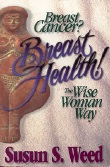
|
Breast Cancer? Breast Health!
Author: Susun S. Weed.
Foods, exercises, and attitudes to keep your breasts healthy. Supportive complimentary medicines to ease side-effects of surgery, radiation, chemotherapy, or tamoxifen. Foreword by Christiane Northrup, M.D. 380 pages, index, illustrations.
Retails for $21.95
Order at: www.wisewomanbookshop.com
|
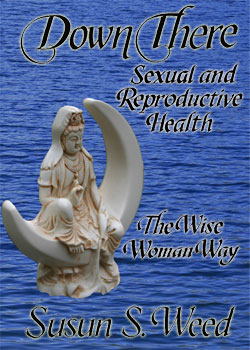
|
Down There: Sexual and Reproductive Health the Wise Woman Way
Publication date: June 21, 2011
Author: Susun S. Weed
Simple, successful, strategies cover the entire range of options -- from mainstream to radical -- to help you choose the best, and the safest, ways to optimize sexual and reproductive health.
Foreword: Aviva Romm, MD, midwife, 484 pages, Index, illustrations.
Retails for $29.95
Order at: www.wisewomanbookshop.com
|
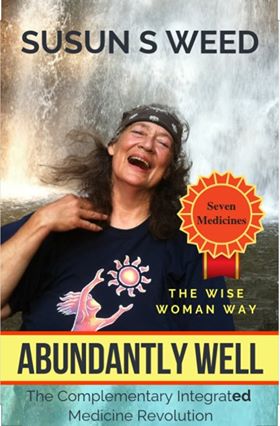
|
Abundantly Well - Seven Medicines
The Complementary Integrated Medical
Revolution
Publication date: December 2019
Author: Susun S. Weed
Seven Medicines build foundational health and guide you to the best health care when problems arise.
Includes case studies, recipes, exentsive references and resources. Introduction by Patch Adams illustrated by Durga
Yael Bernhard 352 pages, index, illustrations
Retails for $24.95
Order at: www.wisewomanbookshop.com
|
|
|
|
Wise Woman Herbal Ezine is sponsored by
www.susunweed.com and www.wisewomanbookshop.com
HEALING WISE | Q & A with SUSUN | GREEN BLESSINGS
THE LIBRARY | PEOPLE MAKING CHANGE | GODDESS ART GALLERY
©Susun
Weed -Wise Woman Center
~ Disclaimer & Privacy Policy ~
|










